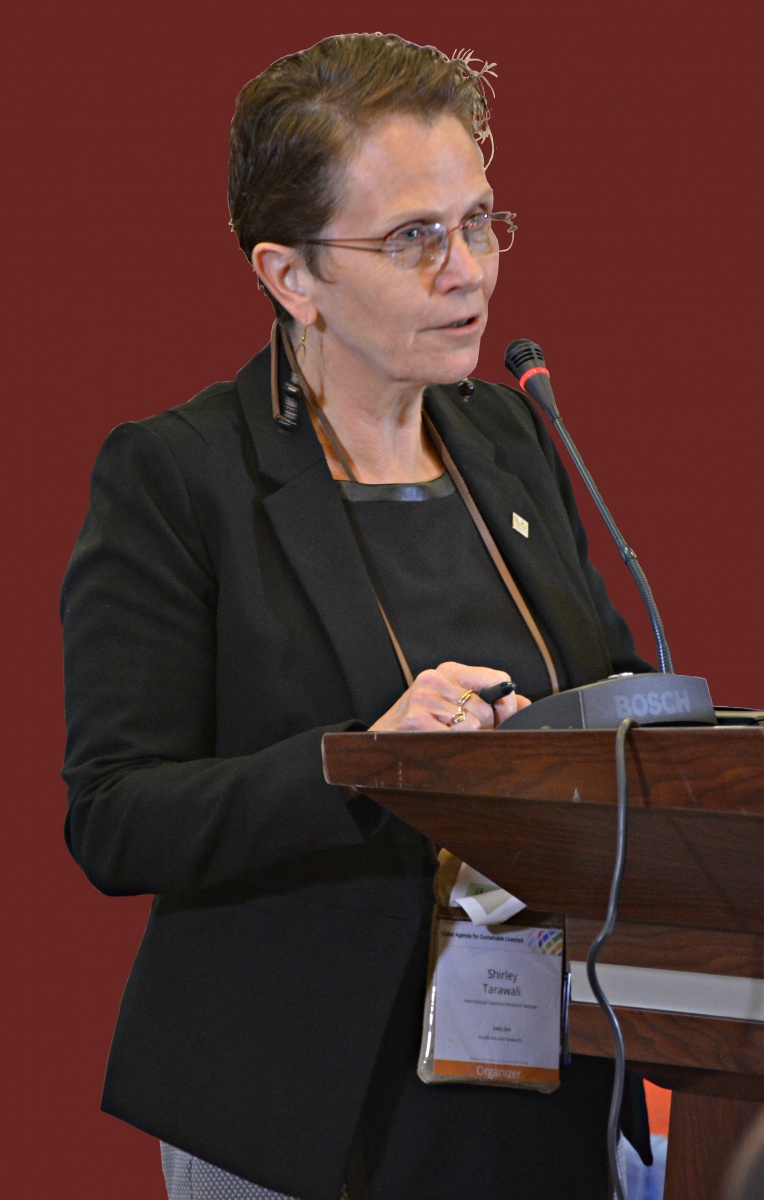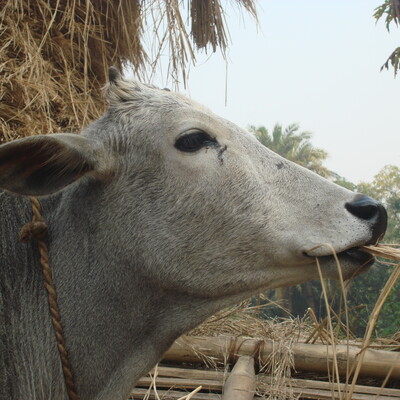
Exploring livestock issues in the context of feeding the world in times of pandemics and climate change
The header image was painted by primary school children from Kangemi, Kenya at ILRI's Mazingira Centre in 2015 (photo credit: ILRI/Susan MacMillan).
Experts from the International Livestock Research Institute (ILRI) were well-represented at the Global Forum for Food and Agriculture (GFFA) held 18-22 January 2021, which focused this year on the very timely issue of ‘How to feed the world in times of pandemic and climate change’. The GFFA is an international conference on global agricultural and food policies held in Berlin on an annual basis under the auspices of the German Federal Ministry of Food and Agriculture (BMEL). Attending the conference (virtually) were several of ILRI’s senior staff, including Dieter Schillinger, deputy director general of research and development for biosciences (see story here); contributing scientist Delia Randolph (see story here); and Shirley Tarawali, assistant director general of the International Livestock Research Institute (ILRI) and chair of the Global Agenda for Sustainable Livestock (GASL). All stressed the importance of incorporating livestock into planning to respond to the immediate crisis posed by the pandemic as well as the rolling, ongoing crisis of climate change.
Tarawali spoke on 21 January at an expert GFFA panel titled Advancing the Three Pillars of Sustainability through Better Livestock Health & Welfare: A Data and Evidence Review, about how better livestock health and welfare can improve social sustainability. The panel was organised and sponsored by Bundesverband für Tiergesundheit e.V., HealthforAnimals and AnimalhealthEurope, and chaired by Roxane Feller, the secretary general of AnimalhealthEurope. Other speakers at the panel covered the environmental and economic dimensions of livestock sustainability.
The session was predicated on the belief that taking care of animals is not only important for animals and their keepers, but for protecting public health and the environment. For example, healthy animals emit less GHG emissions and require fewer inputs. But the quality of the data regarding how the health and welfare of livestock can advance economic, social and environmental sustainability remains uneven, said the panellists.

Shirley Tarawali (photo credit: ILRI/Susan Macmillan).
Tarawali framed her presentation on the social sustainability impacts of animal health around two linked perspectives: On the one hand, the way COVID-19 has provided an all-too-vivid illustration of the animal-human health connection; and on the other, the multiple negative social impacts of the pandemic.
She reviewed the social costs of COVID-19, which is most likely a zoonotic disease—that is, one that spilled into humans from animals. ‘The costs of COVID-19 are said to be in the trillions of dollars’, said Tarawali. ‘More than 100 million people have been pushed into poverty; millions of students aren’t getting a proper education, and there are dire predictions about how many people will become hungry because of this.’
An on-the-ground example of the effects of COVID-19 comes from the results of a phone survey conducted by ILRI scientists on the livestock value chain in northern Kenya during the pandemic. The survey found that the pandemic had serious ramifications up and down the supply chain: pastoralists suffered from diminished sales and income and had to lay off workers as a result; fewer agricultural inputs were purchased because of lowered demand; curfew and inter-country restrictions reduced livestock stocks; slaughterhouses and abattoirs were running well below capacity; distributors and retailers saw serious reductions in the amount of meat being sold; and consumers were purchasing less meat due to un- and under-employment, as well as reducing their use of nutrition and health services.
Tarawali reviewed some of the ways that healthy, well-cared for and productive animals contribute to sustainable and inclusive future livelihoods worldwide—not just in developing countries, but developed ones as well: They can function as an asset and safety net, helping to prevent people from falling into poverty; they are essential for balanced nutrition, especially during the first 1,000 days of life; they are especially important to women, for whom in LMICs they are often the only portable asset; they are fundamental to millions of livelihoods and in developing countries provide employment to as many as one in five of the labour force. Finally, livestock provide on average 40% of the agricultural GDP of a nation—although that number can vary from 15% to 80% depending on the country. ‘So if the animals are healthy, if they are well cared for, if the diseases are properly addressed, then the animals can play an important role in many social sustainability dimensions’, she said.
Tarawali concluded by listing a few lessons learned or policy actions that should be kept in mind to ensure that addressing animal health and welfare is also able to contribute to social sustainability outcomes:
Do not overlook the positive, often essential roles of sustainable livestock for social dimensions, which can be subtle and harder to measure than health or environmental impacts: ensure trade-offs are taken into account and unintended consequences are avoided;
Invest in One Health – and make it practical! For example, develop multi-stakeholder projects to address zoonoses, food safety and anti-microbial resistance by breaking institutional barriers at all levels;
Recognise and harness diversity in all its forms: Disciplinary—from systems analysis to animal disease to epidemiology; geographic—from the local village to global; institutional, from low- to high-tech solutions; and develop for each appropriate standards, compliance mechanisms and incentives. (GASL provides a forum to harness diversity across the livestock sector doing some of this work.)
Support awareness and engagement actions to ensure livestock roles in social sustainability are included in livestock-specific and wider development policies/agendas
Invest and use the latest technologies at a faster pace ‘innovation expedited’ everywhere (for example, with genomics for pathogen detection, IT for biosecurity, big data for AMR, and so on).
Support sustainable livestock enterprises through financing, business and trade innovations.
Other experts on the panel included Jude Capper of the Livestock Sustainability Consultancy, who covered the environmental sustainability dimensions of animal health and welfare. She used as a case study the animals lost in China to a recent outbreak of African swine fever. She calculated that raising them had emitted 30.2-45.3 million tons of greenhouse gas emissions—an environmental cost equal to the average annual emissions of 16.7-25.1 million cars. The culled animals would have provided enough meat for more than 500 million people for a year. This is an example, she said, of the broader need for better data to understand the linkages and opportunity costs of animal health and environmental consequences.
Anne Mottet, a livestock development officer with the Food and Agriculture Organisation, focused on the economic aspects of livestock sustainability. She pointed out livestock is central to the livelihoods of around one billion people living on less than $2 a day, and emphasized the contributions of livestock to livelihood, poverty reduction, but also to economic growth and employment. Claire Bury, deputy director-general of the European Commission's Health and Food Safety Directorate, built on the panel’s interventions. She spoke about the need for an integrated, holistic approach to fashion appropriate policy responses: ‘If we can base ourselves on sound evidence and data, if we can push, as we've been talking about today, towards having more evidence and sound data, if we can do things in a holistic way, then we can talk about the right sustainable policies’.
The GFFA concluded with a commitment by the Berlin Agriculture Ministers’ Conference to redouble their work on climate-friendly and crisis-resistant agriculture. They developed a communiqué for the UN Special Envoy for the World Food Summit 2021, to raise awareness of the food systems’ vulnerabilities that have been revealed by climate change and COVID-19 and to foster technological, organisational, social and entrepreneurial innovations in both crop and animal agriculture to confront and overcome these challenges.
















